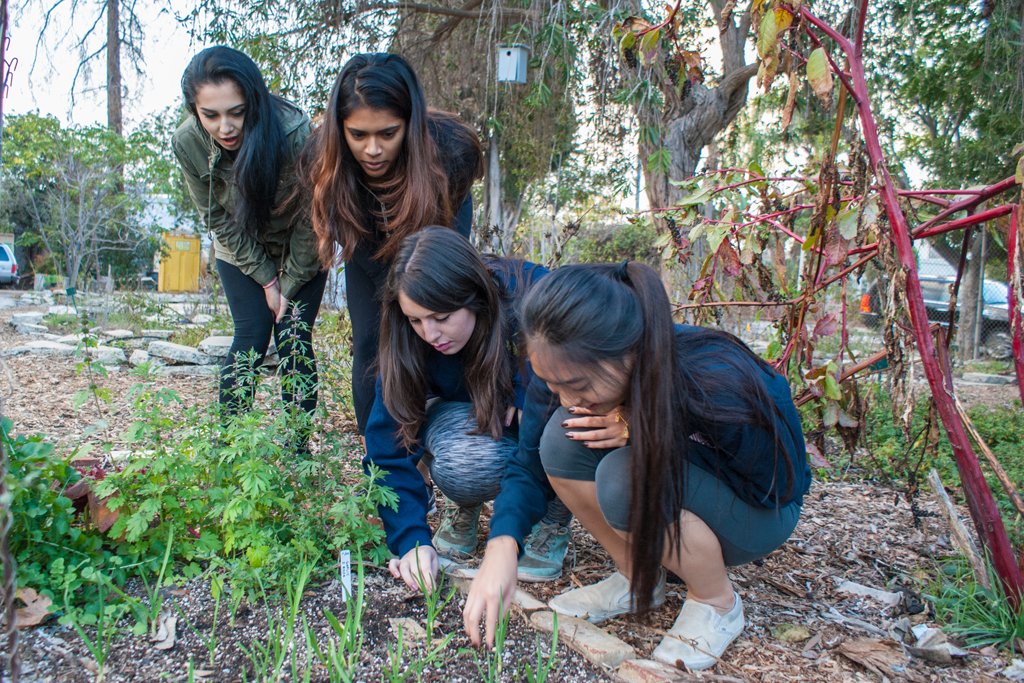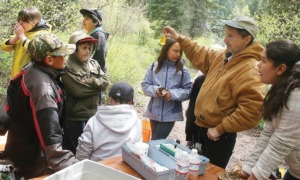LOS ANGELES — You could call it a story of two gardens.
The Learning Garden was established in 2002, planted and maintained by a mix of high school and UCLA extension students, volunteers and the community alike. Its intent, says garden master David King, is to facilitate the cooperation of individuals to build a more vibrant local community — one made up of gardeners growing their own food and some historic context as well.
King pulled out a wad of cotton from his pocket and moseyed to a cotton tree on the property.
“Prior to the Civil War, blacks were not permitted to grow white cotton for their own purposes,” he said. “Only colored cotton.”
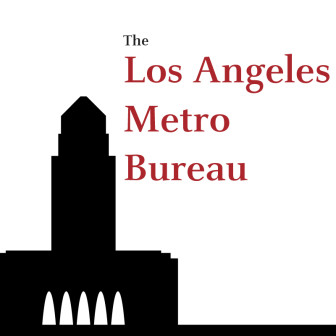 A soon-to-be planted brown cotton seed will soon sprout to provide visitors, volunteers and students with a tangible nod to history and the culture of gardening. But, King said, there are lessons in cotton and gardening in general suitable for all ages. The already-existing arbor provides cotton that King donates to a local preschool where children learn to spin it. He hopes to soon extend the program to the high school where important cultural and community connections can be made.
A soon-to-be planted brown cotton seed will soon sprout to provide visitors, volunteers and students with a tangible nod to history and the culture of gardening. But, King said, there are lessons in cotton and gardening in general suitable for all ages. The already-existing arbor provides cotton that King donates to a local preschool where children learn to spin it. He hopes to soon extend the program to the high school where important cultural and community connections can be made.
In contrast, the garden space at Jefferson Elementary School, less than 30 miles away, is a work in progress, gearing up to teach students about Latino culture and increase their access to healthy foods, as their school administrators and parents plan.
Jefferson is one of more than 100 schools throughout Los Angeles County aiming to incorporate gardening in its core curriculum. And the Pasadena Unified School District public school garden is just one part of a larger movement of communities, individuals and nonprofits throughout Los Angeles County aiming to establish more school and urban gardens to help combat food insecurity and obesity and improve wellness.
Growing an understanding of heritage
Nationwide, a 2010 White House Task Force on Childhood Obesity report to the president found that one out of every three children are overweight or obese, and one-third of all children born in 2000 are expected to develop diabetes in their lifetime. The report also found that childhood obesity is higher among minorities.
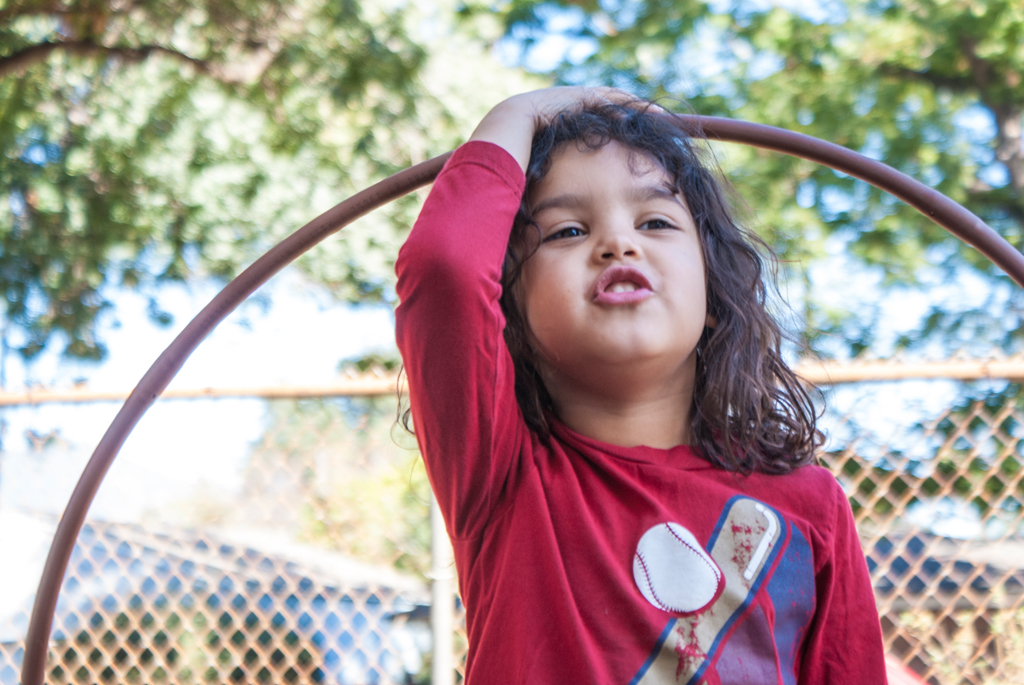
Ajani Harris, 5, pretends a piece of irrigation hose is a rainbow while playing in what will become the school’s Latino Heritage Garden.
It cited school and community gardens as a way to educate students about healthy eating, increase access to affordable and nutritious foods where they may not be readily available, and listed gardening as a suitable physical activity with which children could fill a daily recommended 60-minute activity minimum. For gardening practitioners, however, benefits extend further.
“A community garden in a school benefits those with health and learning disabilities,” said Laura Diaz Allen, Pasadena Education Network engagement director and a PUSD parent. “Poor kids don’t eat well. And kids who don’t eat well don’t learn well.”
This isn’t the first time the school has tried to implement a garden. At the December 2016 dig, all that remained of a previous effort were two thick rosemary bushes. In the past, Jefferson Elementary School Principal Amin Oria said, the garden proved too difficult to maintain without the robust support of teachers and parent volunteers.
For Jeff Mailes, a garden ranger at Los Angeles-based nonprofit Enrich LA, the struggle to sprout lasting school gardens is a familiar story. A garden’s failure to thrive, he said, isn’t necessarily a school’s falling short. It’s an organizational problem that grows from the ground up. He was on hand at Jefferson in December to ensure garden efficiency and ease of maintenance.
Since its beginning in 2011, Enrich LA has built beds at 103 schools throughout Los Angeles County and has established gardens with ranger-led curriculum and maintenance in 73 of them.
“You have growth neglected because the school population is gone during the biggest growing season of the year,” Mailes said. “The teachers, students and their parents are transient, and when that passionate administration or community component gets lost, a garden fails.”
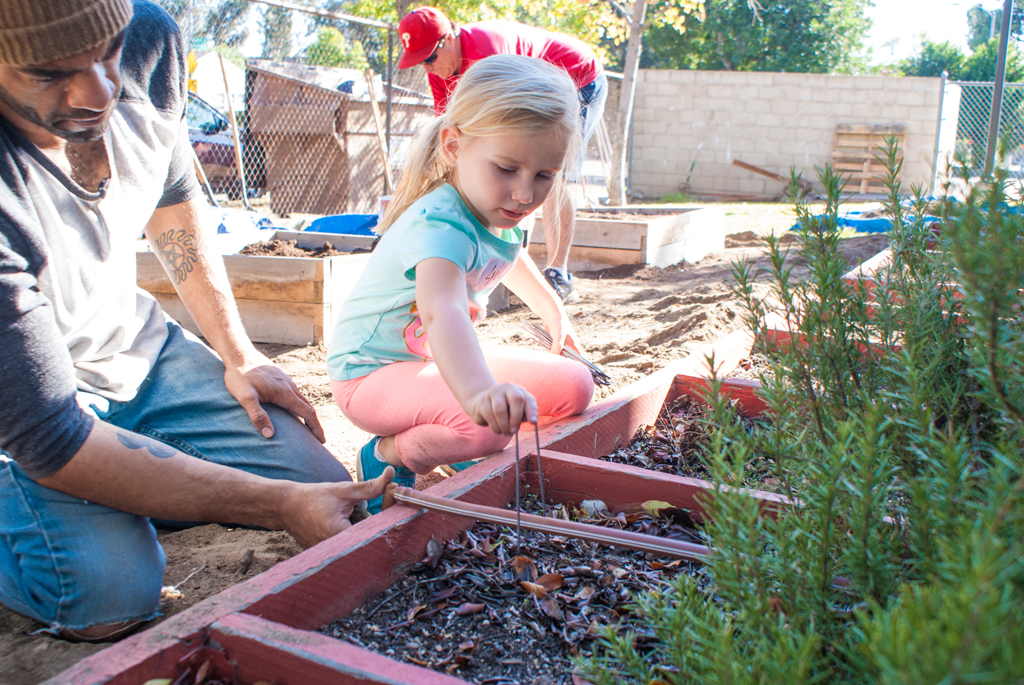
Lydia Little, 5, stakes an irrigation hose into the soil of a Jefferson Elementary School garden bed that will soon be full of a variety of South American produce. The garden, according to parent organizer Kirsten Harmon, will serve as the school’s cultural center tying together various lessons in its dual-language immersion program.
The involvement of dedicated organizations, he said, can be the make-or-break in a school garden. An Enrich LA project is guaranteed a garden ranger who serves as a teacher, gardener and plumber and is responsible for community outreach at each of the 73 sites. More importantly, when school is out, rangers maintain the properties to ensure survival of their programs.
Schools working with Enrich LA are asked to contribute to annual supply and maintenance costs on a sliding scale ranging from $5,175 to $9,660, based on a school’s classification: Title I public school, non-Title I public and charter schools, or private school.
At Jefferson, Enrich LA donated materials, time and expertise to get the Latino heritage garden going. For now, the garden will have its own curriculum, and its planting and maintenance will depend on the dedication of parent and teacher volunteers. The school is still in the process of finding grant money that will allow for Enrich LA’s continued contribution.
“We want to focus on plants grown in Spanish-speaking countries all around the world that can also thrive in this region,” said Jefferson parent and garden organizer Kirsten Harman. “We want it to become a Latino heritage garden, and really honor the cultures. There’s nothing more central to each culture than its food, where it comes from and how it’s prepared.”
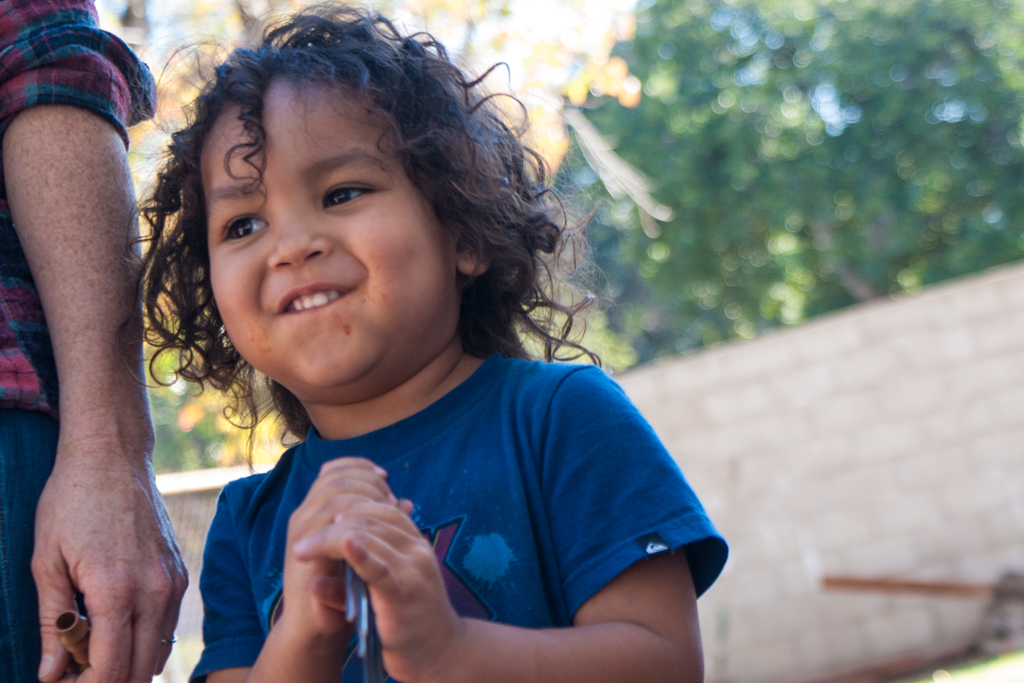
Omari Harris, 3, grasps on to some metal garden stakes.
In the Pasadena Unified School District (PUSD), 60.7 percent of students identify as Latino, according to 2015-16 student forecast demographics. GreatSchools.org data reports Jefferson’s student population is 86 percent Latino, 6 percent black and 4 percent white.
The garden at Jefferson aims to address food insecurity on a small scale — but is mostly focused on the cultural lessons and the fact that if kids are hungry, they aren’t learning.
Perched on the back of his truck after the Jefferson garden revamp, Mailes discussed the importance of sharing the “gospel of urban gardening” with youth — particularly in low-income communities.
“Everything we need can be found in a garden. Food, shelter, water, air. Not money, not iPads,” Mailes said. “Once we get people taken care of on that most basic level, we can stop subsidizing the things that make us sick, and start subsidizing the things that make us better.”
Changing the soil
Nineteen miles away, in South Central Los Angeles, The Ron Finley Project has literally taken to the streets in an effort to nourish what the founder calls South Central’s soil.
“The soil I’m speaking of is the culture. Life comes out of the soil. We are the soil of this planet. We’re also seeds,” said RFP founder Ron Finley. “If you nurture — if you put compost or worm tea on this seed, you’re going to get a vibrant plant. Same with us. If you open the right lessons to a child, that’s going to be with them for life.”
Finley is best known as the TED Talks self-professed “gangsta gardener,” who was largely responsible for the 2015 changes to an LA city ordinance that formerly prohibited growing food in the public land between a personal property and the street without a $400 permit. The Ron Finley Project is an effort to transform the neighborhood into a well-balanced food oasis and ignite what its founder calls a horticultural revolution.
The population of South Central is 56 percent Latino, 38 percent African-American and largely made up of 19- to 34-year-olds making less than $20,000 a year, according to 2000 U.S. Census data organized by the LA Times.
Almost 30 percent of South Central’s population suffer from food insecurity, according to the 2014 LA Public Health Department report. Plus, low-income neighborhoods have limited access to nutritious foods, and public schools in densely commercial, low-income neighborhoods are more likely to have fast-food restaurants nearby than those in wealthier neighborhoods, a 2011 LA County report on obesity found.
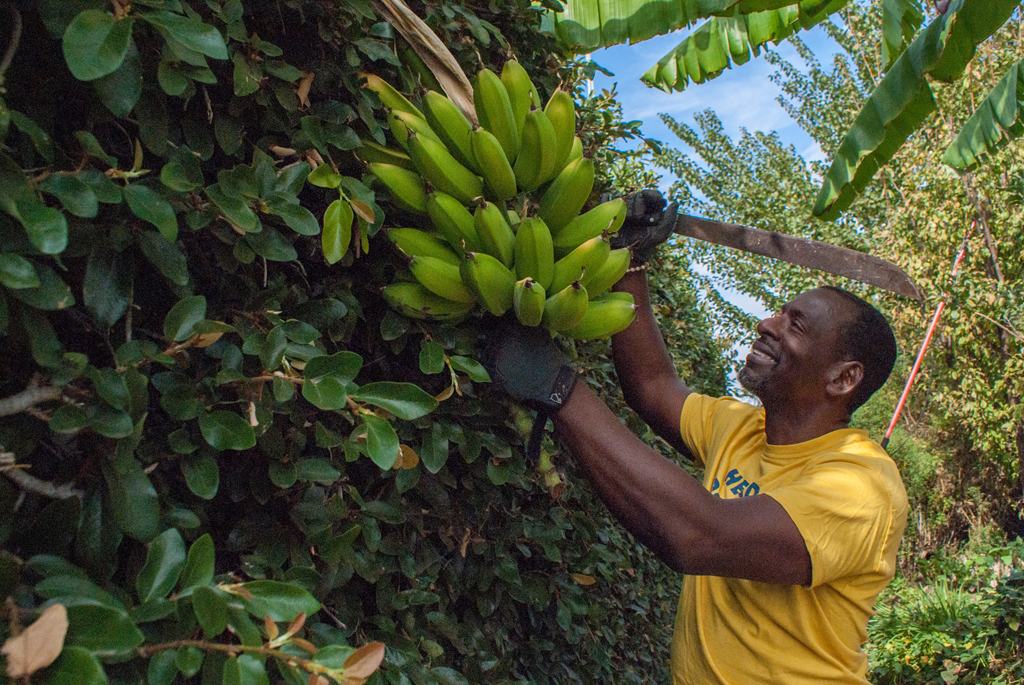
Ron Finley chops a bunch of bananas from a tree planted in his greenway garden. Finley would love to see towering gardens full of produce on every South Central block in an effort to increase self-reliance and access to healthy foods in the region of Los Angeles called the food desert.
Finley’s goal is to empower low- and middle-income families to depend on themselves rather than corporations or the government to provide them with affordable, nutritious whole foods. The concept is that in planting food in the public spaces in front of homes, the whole block could essentially be a drive-thru garden oasis in the midst of an area known to be a food desert. Neighbors could pair up to create gardens to yield organic healthy meals; tomatoes and lettuce in one plot, carrots and radish in another.
“You are a slave if you don’t farm,” Finley said. “If you don’t grow any of your own food, you’re a slave to the system that’s controlling you.”
Finley feels accessible food education, from its historic roots to the tasteful preparation of a variety of produce, is necessary to make an effective change.
“We want there to be food curriculum, to have a young child know what kind of lettuce this is. This is red leaf, this is butter lettuce. It’s very easy. If you put it there, they’ll get it.”
Teaching autonomy via slow-growing gardens in a fast-paced digital world is a steep task that garden master King knows well.
“Learning to grow some of your own food is essential. And I think learning to work as a part of a community is essential. And I don’t think Angelenos are equipped to do either very well,” he said.


